-
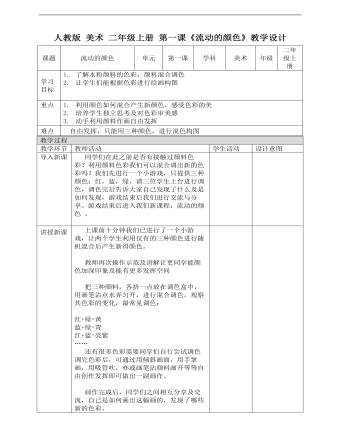
小学美术人教版二年级上册《第1课流动的颜色》教案说课稿
同学们在此之前是否有接触过颜料色彩?利用颜料色彩我们可以混合调出新的色彩吗?我们先进行一个小游戏,只提供三种颜色:红,蓝,绿,请三位学生上台进行调色,调色完后告诉大家自己发现了什么及是如何发现,游戏结束后我们进行交流与分享。游戏结束后进入我们新课程:流动的颜色 。
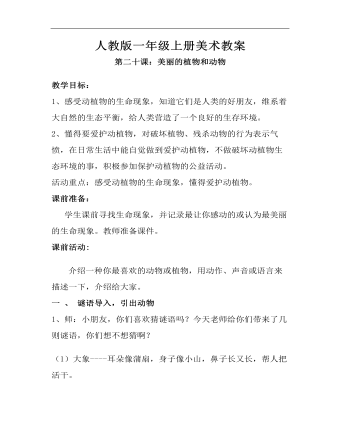
小学美术人教版一年级上册《第20课美丽的植物和动物》教案说课稿
2、懂得要爱护动植物,对破坏植物、残杀动物的行为表示气愤,在日常生活中能自觉做到爱护动植物,不做破坏动植物生态环境的事,积极参加保护动植物的公益活动。活动重点:感受动植物的生命现象,懂得爱护动植物。
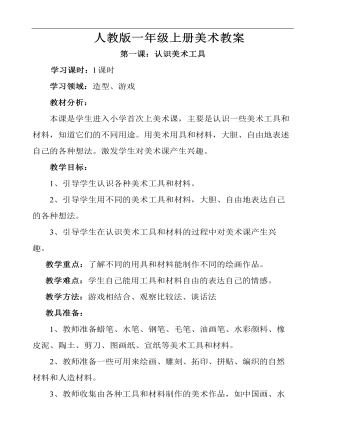
小学美术人教版一年级上册《第1课认识美术工具》教案说课稿
1、引导学生认识各种美术工具和材料。2、引导学生用不同的美术工具和材料,大胆、自由地表达自己的各种想法。3、引导学生在认识美术工具和材料的过程中对美术课产生兴趣。教学重点:了解不同的用具和材料能制作不同的绘画作品。教学难点:学生自己能用工具和材料自由的表达自己的情感。教学方法:游戏相结合、观察比较法、谈话法
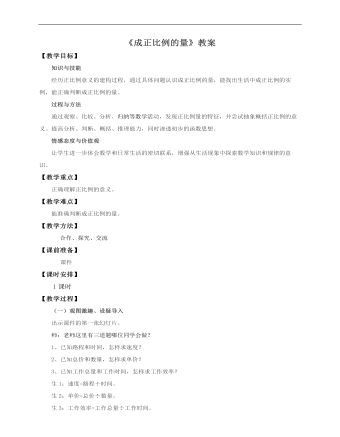
小学数学人教版六年级下册《第一课成正比例的量》教案说课稿
(一)观图激趣、设疑导入 出示课件的第一张幻灯片。师:老师这里有三道题哪位同学会做?1、已知路程和时间,怎样求速度?2、已知总价和数量,怎样求单价?3、已知工作总量和工作时间,怎样求工作效率?生1:速度=路程÷时间。生2:单价=总价÷数量。生3:工作效率=工作总量÷工作时间。师:同学们可真棒!这节课我们就来研究这些数量间的一些规律和特征。你们准备好了吗?生:准备好了!(板书:成正比例的量)【设计意图】引发学生学习的兴趣,唤起学生已有的只是经验,更好地进行新旧知识的结合,也有利于引导学生发现数量关系内在的规律。(二)探究新知(PPT课件出示例1)文具店有一种铅笔,销售的数量与总价的关系如下表。 数量/支12345678…总价/元3.5710.51417.52124.528…观察上表,回答下面的问题。(1)表中有哪两种量?(2)总价是怎样随着数量的变化而变化的?(3)相应的总价与数量的比分别是多少?比值是多少?1.探究数量与总价两个量之间的关系。师:仔细观察这张表格,它为我们提供了哪些数学信息?生:给我们提供了文具店销售彩带的数量是1,2,3,4,5,6,7,8米,总价分别是:3.5, 7,10.5,14,17.5,21,24.5,28元。师:表中有哪两种量?生:有数量和总价两种量。师:总价是怎样随着数量的变化而变化的?生:总价是随数量的增加而增加的。师:相应的总价与数量的比分别是多少?比值是多少?生1:=3.5 =3.5 =3.5 =3.5 =3.5 =3.5 =3.5 =3.5生2:相对应的总价和数量的比的比值是一定的。师:总价与数量的比值表示什么?
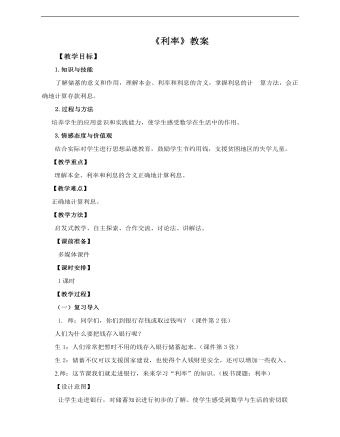
小学数学人教版六年级下册《第四课利率》教案说课稿
2.过程与方法 培养学生的应用意识和实践能力,使学生感受数学在生活中的作用。3.情感态度与价值观结合实际对学生进行思想品德教育,鼓励学生节约用钱,支援贫困地区的失学儿童。 【教学重点】 理解本金、利率和利息的含义正确地计算利息。 【教学难点】 正确地计算利息。【教学方法】启发式教学、自主探索、合作交流、讨论法、讲解法。【课前准备】 多媒体课件【课时安排】 1课时【教学过程】(一)复习导入 1. 师:同学们,你们到银行存钱或取过钱吗?(课件第2张)人们为什么要把钱存入银行呢?生1:人们常常把暂时不用的钱存入银行储蓄起来。(课件第3张)生2:储蓄不仅可以支援国家建设,也使得个人钱财更安全,还可以增加一些收入。2.师:这节课我们就走进银行,来来学习“利率”的知识。(板书课题:利率)
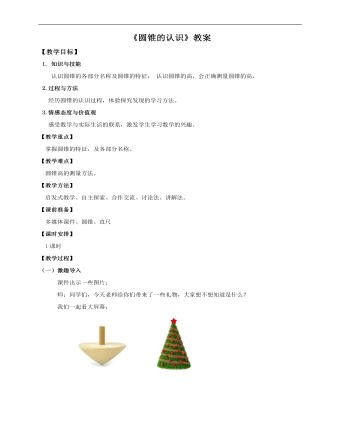
小学数学人教版六年级下册《第四课圆锥的认识》教案说课稿
2.过程与方法 经历圆锥的认识过程,体验探究发现的学习方法。3.情感态度与价值观 感受数学与实际生活的联系,激发学生学习数学的兴趣。【教学重点】 掌握圆锥的特征,及各部分名称。【教学难点】圆锥高的测量方法。【教学方法】启发式教学、自主探索、合作交流、讨论法、讲解法。【课前准备】多媒体课件、圆锥、直尺
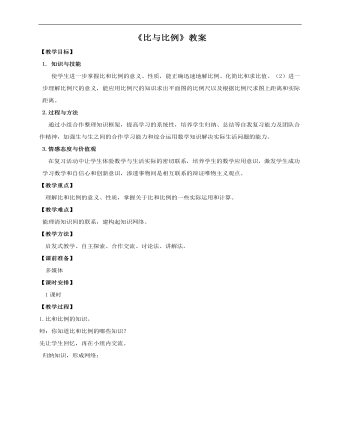
小学数学人教版六年级下册《第四课比与比例》教案说课稿
2.过程与方法 通过小组合作整理知识框架,提高学习的系统性,培养学生归纳、总结等自我复习能力及团队合作精神,加强生与生之间的合作学习能力和综合运用数学知识解决实际生活问题的能力。3.情感态度与价值观在复习活动中让学生体验数学与生活实际的密切联系,培养学生的数学应用意识,激发学生成功学习数学和自信心和创新意识,渗透事物间是相互联系的辩证唯物主义观点。【教学重点】 理解比和比例的意义、性质,掌握关于比和比例的一些实际运用和计算。【教学难点】能理清知识间的联系,建构起知识网络。【教学方法】启发式教学、自主探索、合作交流、讨论法、讲解法。【课前准备】
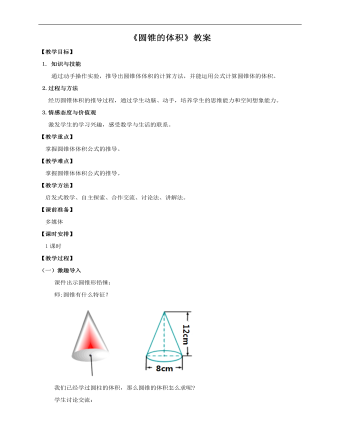
小学数学人教版六年级下册《第五课圆锥的体积》教案说课稿
(二)探究新知 1. 探究圆锥的体积的计算方法,学习例2。师:圆锥的体积和圆柱的体积有没有关系呢?圆柱的底面是圆,圆锥的底面也是圆……通过实验探究一下圆锥和圆柱体积之间的关系。小组合作探索:(1)各组准备好等底、等高的圆柱、圆锥形容器。(2)用倒沙子或水的方法试一试。(3)圆锥的体积与同它等底等 高的圆柱体积之间有什么关系?(4)小组活动,师巡视指导。2.推导圆锥体积的计算方法。 (1)课件演示等底等高的圆柱和圆锥
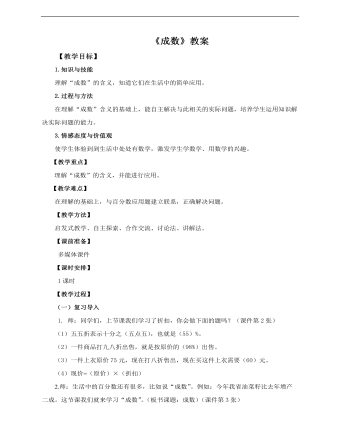
小学数学人教版六年级下册《第二课成数》教案说课稿
(一)复习导入 1. 师:同学们,上节课我们学习了折扣,你会做下面的题吗?(课件第2张)(1)五五折表示十分之(五点五),也就是(55)%。 (2)一件商品打九八折出售,就是按原价的(98%)出售。(3)一件上衣原价75元,现在打八折售出,现在买这件上衣需要(60)元。(4)现价=(原价)×(折扣)2.师:生活中的百分数还有很多,比如说“成数”。例如:今年我省油菜籽比去年增产二成。这节课我们就来学习“成数”。(板书课题:成数)(课件第3张)【设计意图】 “折扣”与“成数”虽然运用不一样,但解决方法大致相同,复习不仅可以起到巩固作用,也能让学生对新知的解决有一些铺垫。(二)探究新知 1、探究成数的含义以及成数和百分数的关系。(课件第4张)(1)农业收成,经常用成数来表示。你知道什么是成数吗? 生1:成数表示一个数是另一个数的十分之几,通称“几成”。“一成”就是十分之一,改写成百分数是10%。(2)填一填。(课件第5张)“二成”就是(十分之二),改写成百分数是(20%);“三成五”就是(十分之三点五),改写成百分数是(35%)。“四成三”就是(十分之四点三),改写成百分数是(43%);“六成五”就是(十分之六点五),改写成百分数是(65%)。(3)把下面的成数改写成百分数。 (课件第6张)三成=(30)% 四成六=(46)% 九成九=(99)% 二成五=(25)% 一成二=(12)% 七成三=(73)%
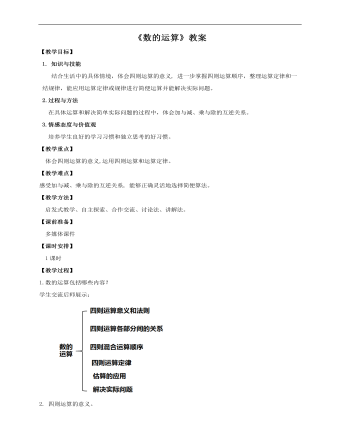
小学数学人教版六年级下册《第二课数的运算》教案说课稿
2.四则运算的意义。(1)知识梳理师:我们学过哪些运算?举例说明这些运算的含义。生:把两个(或几个)数合并成一个数的运算,叫做加法。 已知两个加数的和与其中的一个加数,求另一个加数的运算,叫做减法。 求几个相同加数的和的简便运算。 已知两个因数的积与其中一个因数,求另一个因数的运算。 师:整数、小数、分数四则运算有什么相同点?学生交流后师总结:加减法:都是把相同计数单位的数相加减。乘除法:小数乘除法把除数转化成整数再计算。分数除法要转化成分数乘法计算。师:整数、小数、分数四则运算有什么不同点?生:小数乘、除法还要在计算结果上确定小数点的位置,分数除法转化后乘的是除数的倒数。师:如果有0或者1参与四则运算,有哪些特殊情况?(学生讨论交流)生:任何数加减0都得原数。
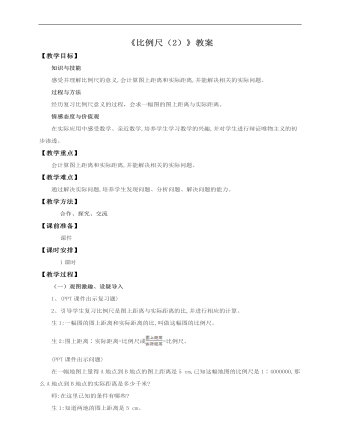
小学数学人教版六年级下册《第一课比例尺(2)》教案说课稿
(一)观图激趣、设疑导入 1、(PPT课件出示复习题)2、引导学生复习比例尺是图上距离与实际距离的比,并进行相应的计算。生1:一幅图的图上距离和实际距离的比,叫做这幅图的比例尺。生2:图上距离∶实际距离=比例尺或=比例尺。(PPT课件出示问题)在一幅地图上量得A地点到B地点的图上距离是5 cm,已知这幅地图的比例尺是1∶4000000,那么A地点到B地点的实际距离是多少千米?师:在这里已知的条件有哪些?生1:知道两地的图上距离是5 cm。生2:知道比例尺是1∶4000000。师:要解决的问题是什么?生:计算两地的实际距离是多少千米。师:这节课我们就接着来学习比例尺的应用,学习如何利用比例尺来解决实际问题,也就是已知比例尺和图上距离,求实际距离。(板书课题)【设计意图】通过把复习题中的习题变换已知和未知条件来变成本节课要解决的问题,使学生产生浓厚的兴趣,并且,也有助于培养学生举一反三、触类旁通的能力,使学生认识到数学知识的灵活性。(二)探究新知探究学习例2,已知比例尺和图上距离,求实际距离。1、PPT课件出示P54例3。下面是北京轨道交通路线示意图。地铁1号线从苹果园站至四惠东站在图中的长度大约是7.8 cm,从苹果园站至四惠东站的实际长度大约是多少千米?2、引导学生分析探究:师:从例题中可以知道哪些已知条件?生:可以知道两站的图上距离大约是7.8cm。师:这是从题目中直接读出来的,那么从所给的图中还能观察到什么条件呢?生:可以知道比例尺是1∶400000。布置学生小组讨论怎么样解决问题。学生以小组为单位进行合作学习,教师进行指导。3、汇报学习成果,师生共同探究:师:你们是怎么解答的?生1:通过列方程来解答的。生2:根据题意,可以先设实际长度为x cm,再根据“图上距离∶实际距离=比例尺”,列方程解答。师:解答时要注意什么?生1:要求实际距离是多少千米,但已知的图上距离是多少厘米,可以先设实际距离为x cm,算出实际距离的厘米数后,再化成千米数。生2:根据“图上距离∶实际距离=比例尺”,可以用解比例的方法求出实际距离。4、完成解答:(板书解题过程)图上距离:实际距离=比例尺解:设从苹果园站到四惠东站的实际长度是x cm。=x=7.8×400000x=31200003120000 cm=31.2 km答:从苹果园站到四惠东站的实际长度大约是31.2 km。5、拓展延伸:师:我们除了用方程解答之外,还可以用什么方法解答?生:可以用算术方法解答。师:可以怎样来分析呢?生:在“图上距离∶实际距离=比例尺”中,实际距离既可看成分数的分母,又可看成除法中的除数,所以可得出实际距离=图上距离÷比例尺。师:我们来共同完成解答:(板书过程)图上距离:比例尺=实际距离7.8÷=3120000(cm)3120000 cm=31.2 km答:从苹果园站到四惠东站的实际长度大约是31.2 km。6、牛刀小试。(1)师:我们一起来做两个练习题,看我们对新知识的掌握程度如何。(PPT课件出示)①教材P54做一做。先把教材P54做一做的图中的线段比例尺改写成数值比例尺,再用直尺量出图中河西村与汽车站之间的距离是多少厘米,并计算出两地的实际距离大约是多少。
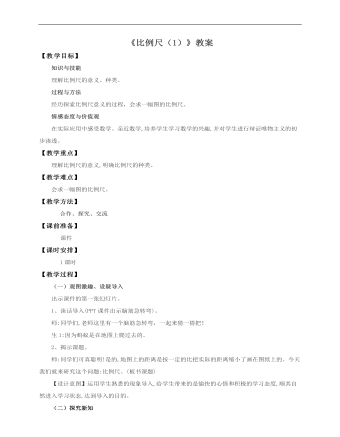
小学数学人教版六年级下册《第一课比例尺(1)》教案说课稿
(一)观图激趣、设疑导入 出示课件的第一张幻灯片。1、谈话导入(PPT课件出示脑筋急转弯)。师:同学们,老师这里有一个脑筋急转弯,一起来猜一猜把!生1:因为蚂蚁是在地图上爬过去的。2、揭示课题。师:同学们可真聪明!是的,地图上的距离是按一定的比把实际的距离缩小了画在图纸上的。今天我们就来研究这个问题:比例尺。(板书课题)【设计意图】运用学生熟悉的现象导入,给学生带来的是愉快的心情和积极的学习态度,顺其自然进入学习状态,达到导入的目的。(二)探究新知教学比例尺的意义及种类,理解比例尺的含义以及关系式。1、阅读教材第53页关于比例尺的内容。师:阅读教材后,汇报你知道了哪些关于比例尺的知识。生1:通过阅读我知道:一幅图的图上距离和实际距离的比,叫做这幅图的比例尺。图上距离∶实际距离=比例尺。(板书比例尺的意义)=比例尺生2:比例尺是绘图时用的,它是把实际距离按一定的比缩小或扩大,再画在图纸上。生3:教材介绍说,地图上的比例尺有1∶100000000,这是数值比例尺,它也可以写成这种形式,也叫数值比例尺。(板书)生4:老师,我看见这样表示比例尺的: 师:这叫线段比例尺。 它表示的是:图上1厘米的距离相当于地面上50 km的实际距离。(板书)生5:我会把上面的线段比例尺改成数值比例尺。图上距离∶实际距离。=1 cm∶50 km=1 cm∶5000000 cm(单位要相同)=1∶5000000(板书过程)生6:比例尺1∶5000000表示图上距离是实际距离的。实际距离是图上距离的5000000倍。
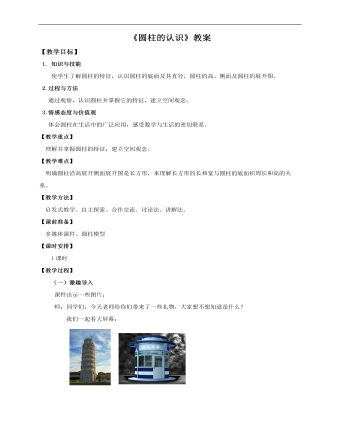
小学数学人教版六年级下册《第一课圆柱的认识》教案说课稿
(一)激趣导入 课件出示一些图片:师:同学们,今天老师给你们带来了一些礼物,大家想不想知道是什么?我们一起看大屏幕:你们认识这些物体吗?在生活中见到过吗?生:比萨斜塔、治安岗亭、茶叶盒、客家围屋。师:今天这节课我们重点来研究这些物体。(二)探究新知 1. 认识圆柱。师:这些物体什么形状的?它们的形状有什么共同特点?生:这些物体都是圆柱形的。师小结:这些物体的形状都是圆柱体,简称圆柱。说一说生活中有哪些圆柱形的物体。2.探究圆柱的特特征。(1)认识底面小组活动: 观察圆柱形物体,看看它是有几部分组成的,有什么特征?课件演示:圆柱的上、下两个面叫做底面,是两个完全相同的圆。 师:请同学们量一量、算一算圆柱的两个底面有什么关系?生1:两个底面的直径相等、半径相等。生2:两个底面的周长相等、面积相等。师小结:圆柱的底面是两个完全相同的圆。(2)认识侧面课件演示:圆柱周围的面叫做侧面,侧面是一个曲面。师:请同学们指一指圆柱的侧面,再用手摸一摸,有什么感觉?生:侧面是弯曲的。师:侧面是一个曲面。
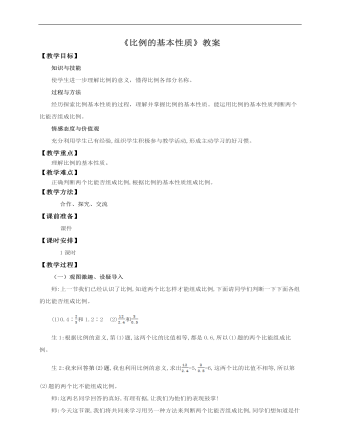
小学数学人教版六年级下册《第二课比例的基本性质》教案说课稿
(一)观图激趣、设疑导入 师:上一节我们已经认识了比例,知道两个比怎样才能组成比例,下面请同学们判断一下下面各组的比能否组成比例。(1)0.4∶和1.2∶2 (2)和生1:根据比例的意义,第(1)题,这两个比的比值相等,都是0.6,所以(1)题的两个比能组成比例。生2:我来回答第(2)题,我也利用比例的意义,求出=5,=6,这两个比的比值不相等,所以第(2)题的两个比不能组成比例。师:这两名同学回答的真好,有理有据,让我们为他们的表现鼓掌!师:今天这节课,我们将共同来学习用另一种方法来判断两个比能否组成比例,同学们想知道是什么方法吗?生:想知道。师:那就是比例的基本性质(板书课题:比例的基本性质)。【设计意图】复习学生已有的知识,唤醒学生已有学习经验,教师的提问吸引了学生的注意力,也引发学生的好奇心,为学习新知识开了一个好头。
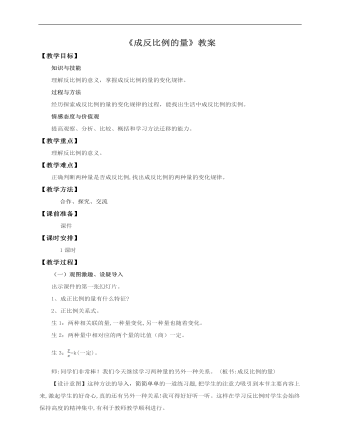
小学数学人教版六年级下册《第二课成反比例的量》教案说课稿
【教学过程】(一)观图激趣、设疑导入 出示课件的第一张幻灯片。1、成正比例的量有什么特征?2、正比例关系式。生1:两种相关联的量,一种量变化,另一种量也随着变化。生2:两种量中相对应的两个量的比值(商)一定。生3:=k(一定)。师:同学们非常棒!我们今天继续学习两种量的另外一种关系。 (板书:成反比例的量)【设计意图】这种方法的导入,简简单单的一道练习题,把学生的注意力吸引到本节主要内容上来,激起学生的好奇心,真的还有另外一种关系!我可得好好听一听。这样在学习反比例时学生会始终保持高度的精神集中,有利于教师教学顺利进行。(二)探究新知教学例2,探究反比例的意义,理解成反比例的量。1、出示PPT课件回答问题。杯子的底面积与水的高度的变化情况如下表。 杯子的底面积/cm²1015203060…水的高度/cm302015105…观察上表,回答下面的问题。(1)表中有哪两种量?(2)水的高度是怎样随着杯子底面积的大小变化而变化的?(3)相对应的杯子的底面积与水的高度的乘积分别是多少?生1:表中有杯子的底面积和水的高度这两种量。生2:从表中可以看出:水的高度随着杯子的底面积的变大而不断变小,这两种量是相关联的两种量。生3:我来回答(3),相对应的杯子的底面积与水的高度的乘积分别是:10×30=15×20=20×15=30×10=60×5=…=300。生4:乘积一定。师:底面积与高的乘积表示的是什么?生:水的体积。(板书)师:你会算出水的体积吗?生:会。(学生计算,教师出示课件订正)2、揭示反比例的意义。师:积是300,实际就是倒入杯子的水的体积。同学们能用式子表示出它们的关系吗?生:它们的关系是:底面积×高=体积。师:同学们,我们用概括正比例意义时的方法来概括一下反比例的意义吧!生:像这样,两种相关联的量,一种量变化,另一种量也随着变化,如果这两种量中相对应的两个数的乘积一定,这两种量就叫做成反比例的量,它们的关系叫做反比例关系。(板书反比例的意义)3、用字母表示反比例关系:xy=k(一定)。(板书)4、牛刀小试。锅炉房烧煤的天数与每天烧煤的吨数如下表: 每天烧煤的吨数/吨11.522.53烧煤的天数/天3020151210(1)表中有哪两种量?它们是不是相关联的量?(2)写出几组这两种量中相对应的两个数的积,并比较大小,说一说这个积表示什么。(3)烧煤的天数与每天烧煤的吨数成反比例吗?为什么?【参考答案】 (1)每天烧煤的吨数和烧煤的天数,是相关联的量。 (2)1×30=30 1.5×20=30 2×15=30 2.5×12=30 3×10=30 积相等,这个积表示这批煤的总吨数。 (3)成反比例,因为烧煤的天数与每天烧煤的吨数的积一定。【设计意图】学生通过观察、发现、概括经历了整个学习过程,逐步形成定向思维方式,为学会学习打好基础。
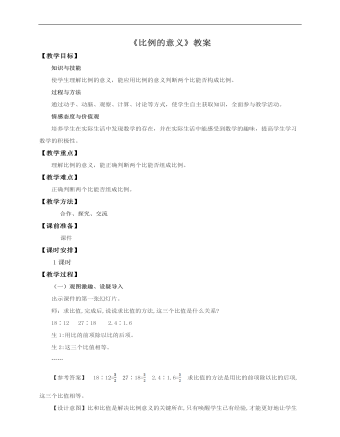
小学数学人教版六年级下册《第一课比例的意义》教案说课稿
(一)观图激趣、设疑导入 出示课件的第一张幻灯片。师:求比值,完成后,说说求比值的方法,这三个比值是什么关系?18∶12 27∶18 2.4∶1.6生1:用比的前项除以比的后项。生2:这三个比值相等。……【参考答案】 18∶12= 27∶18= 2.4∶1.6= 求比值的方法是用比的前项除以比的后项,这三个比值相等。【设计意图】比和比值是解决比例意义的关键所在,只有唤醒学生已有经验,才能更好地让学生投入到学习比例意义活动中来,为实现教学目标做好铺垫。(二)探究新知师:同学们,每周一的早上我们学校都要举行庄严的升国旗仪式,那么,你们对国旗都有哪些了解呢? 生1:我们的国旗是红色的,上面有五颗黄色的五角星。生2:我们的国旗是长方形的。师:同学们回答得真好,说出了自己对国旗的了解,可以看出同学们对我们国家的热爱,老师希望你们一定要好好学习,为我们的五星红旗增光!五星红旗是庄严而美丽的, 并且它与我们数学也有着密切的联系,这也就是我们今天所要研究的内容——比例。(板书课题:比例的意义)国旗长5米,宽米。国旗长2.4米,宽1.6米。国旗长60厘米,宽40厘米。
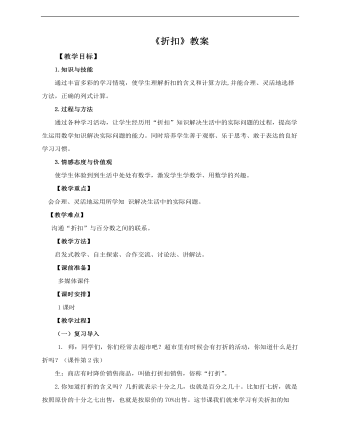
小学数学人教版六年级下册《第一课折扣》教案说课稿
(一)复习导入 1. 师:同学们,你们经常去超市吧?超市里有时候会有打折的活动,你知道什么是打折吗?(课件第2张)生:商店有时降价销售商品,叫做打折扣销售,俗称“打折”。2.你知道打折的含义吗?几折就表示十分之几,也就是百分之几十。比如打七折,就是按照原价的十分之七出售,也就是按原价的70%出售。这节课我们就来学习有关折扣的知识。(课件第3张)【设计意图】联系学生的生活实际引入课题,引起学生学习兴趣,使学生体会到生活中处处有数学。(二)探究新知 1、探究折扣的含义,计算打折后的价钱。(课件第3张)(1)星期天,小雨和爸爸来到商场买东西,正好赶上打折活动。小雨问爸爸:什么叫做“八五折”?你能回答小雨的问题吗?生1:“八五折”就是按原价的85%出售。你知道“九折”是多少吗?生2:“九折”就是按原价的90%出售。(2)爸爸给小雨买了一辆自行车,原价180元,现在商店打八五折出售。买这辆车用了多少钱?你会列式吗?(课件第4张)小组合作:你是怎样想的?说说你的思考过程。(课件第5张)(3)汇报交流:生1:把原价看做单位“1”,打八五折就是按原价的85%出售。(课件第6张)生2:现价=原价×折扣,求现价,做乘法。生3:180×85%=153(元)答:买这辆车用了153元。2、探究计算打折后便宜了多少钱的方法。爸爸买了一个随身听,原价160元,现在只花了九折的钱,比原价便宜了多少元?(课件第7张)(1)小组讨论:先求什么?再求什么?说说你的思考过程。生1:我先求现价是多少,再求比原价便宜了多少元。(课件第8张)列式为:160×90%=144(元)160-144=16(元)答:比原价便宜了16元。生2:我先求现价比原价便宜了百分之几,再求比原价便宜了多少元。(课件第9张)列式为:160×(1-90%)=160×10%=16(元)
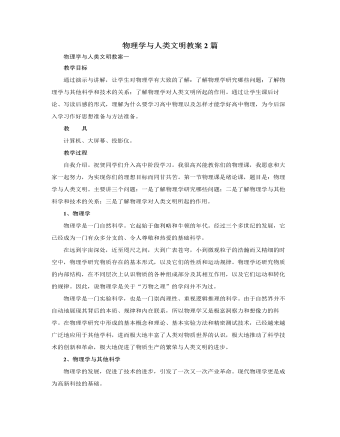
人教版新课标高中物理必修1物理学与人类文明教案2篇
1. 课前观看视频《物理学与人类文明》2. 分组讨论,派代表发言,谈学习感受。主要是物理的地位,物理的学习方法。3. 高中物理与初中物理在内容和方法上的区别高中物理除了现象、概念和规律之外还应该关注研究问题的方法,学会从先想到抽象,从定性到定量研究问题,学会用数学方法解决物理问题,学会实验探究,学会独立分析问题解决问题的思维习惯。4. 高中物理学习的基本要求高中物理学习应该“重视实验,勤于思考”和“经历过程,体验方法”。高中物理学习与初中物理学习虽然有一定区别,但也不是孤立的,要继续坚持初中物理学习中积累的学习方法和体会,重视从正反两个方面加以总结和提炼,做到:(1) 认真阅读,学会自学要学好物理,就要认真阅读课本。阅读课本是要抓住关键词语,弄清语句间的逻辑顺序和因果关系,领会文章段落所表达的物理内容,掌握课本叙述物理问题的表达方法。
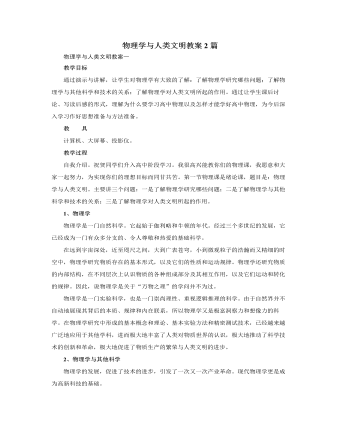
人教版新课标高中物理必修1物理学与人类文明教案2篇
八、物理学的基础地位及物理学对人类文明、社会进步的影响。(1) 情景一:磁悬浮实验:找两个空心的圆柱片磁铁,同名磁极相对,穿在同一根竹筷上,用手压下上面的磁铁,松手观察它的运动情况。问题1:上面的磁铁为什么会跳起来,为什么会悬浮在下面的磁铁上方?问题2:根据这个实验,你会想到那一种交通工具?总结:人们就是从磁悬浮现象中得到启发,进行磁悬浮列车的研究和制造的,这说明物理学在推动社会进步、人类文明方面起到推动作用。(2) 情景二:感应起电和火花放电实验:用感应起电机或感应圈产生火花放电,让学生观察现象,闻气味,然后联想生活实例。还可以用一张纸试着挡住放电的弧光,最好能引燃纸张,说明雷击引起火灾的现象。问题1:你看、听到了什么现象?问题2:根据这个实验,你会想到那一种自然现象?问题3:放电发生在什么地方?为什么建筑物上方都有尖尖的设置,是干什么用的?问题4:你闻到什么气味了吗?
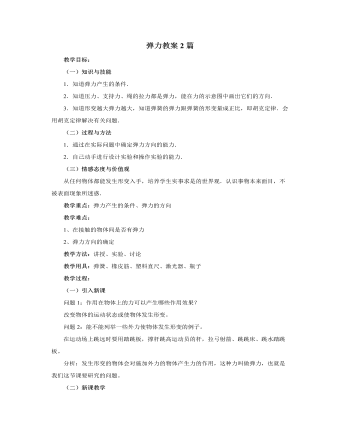
人教版新课标高中物理必修1弹力教案2篇
一般情况下,凡是支持物对物体的支持力,都是支持物因发生形变而对物体产生弹力。所以支持力的方向总是垂直于支持面而指向被支持的物体。例1:放在水平桌面上的书书由于重力的作用而压迫桌面,使书和桌面同时发生微小形变,要恢复原状,对桌面产生垂直于桌面向下的弹力f1,这就是书对桌面的压力;桌面由于发生微小的形变,对书产生垂直于书面向上的弹力f2,这就是桌面对书的支持力。学生分析:静止地放在倾斜木板上的书,书对木板的压力和木板对书的支持力。并画出力的示意图。结论:压力、支持力都是弹力。压力的方向总是垂直于支持面而指向被压的物体,支持力的方向总是垂直于支持面而指向被支持的物体。引导学生分析静止时,悬绳对重物的拉力及方向。引导得出:悬挂物由于重力的作用而拉紧悬绳,使重物、悬绳同时发生微小的形变。重物由于发生微小的形变,对悬绳产生竖直向下的弹力f1,这是物对绳的拉力;悬绳由于发生微小形变,对物产生竖直向上的弹力f2,这就是绳对物体的拉力。